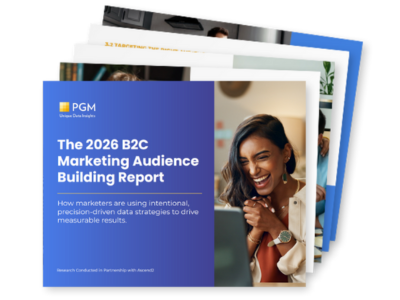Data has become one of the most valuable marketing resources and brands that prioritize data-driven marketing strategies are more likely to succeed. With the right data, such as 1st and 3rd party data, brands can gain insights into consumers’ wants, preferences, prospective purchases and loyalty triggers.
In fact, research shows that 64% of marketing executives strongly agree that data-driven marketing is crucial in today’s landscape.
The most successful data-driven strategies combine 1st party data (direct customer insights) and 3rd party data (collected by data aggregators) to create a comprehensive audience view. Integrating these insights with 2nd party data—shared by trusted partners—and zero-party data, which is voluntarily provided by customers, allows for even more personalized and effective marketing strategies.
What is First-Party Data?
First-party data includes information collected directly from your customers through interactions on your website, app, CRM, and other owned channels. It is incredibly valuable because it provides insights that are specific to your audience. This data is also considered the most reliable because it comes directly from your customers.
Marketers use 1st party data to understand customer behavior, segment audiences, and create tailored messaging that resonates with individual preferences. For example, a brand can use purchase history and browsing behavior to recommend products that align with a customer’s interests, driving higher engagement and conversions.
Examples of 1st party data include:
- Website Analytics: Information like page views, time spent on site, and user navigation paths.
- Purchase History: Data on the products or services a customer has bought from your online store.
- Email Engagement: Metrics such as open rates, click-through rates, and responses to email campaigns.
- Customer Feedback: Insights gathered from surveys, reviews, and customer service interactions.
What is Third-Party Data?
Third-Party Data, on the other hand, is collected by external organizations that are not directly related to the company using the data. This data is typically aggregated from various sources and sold or shared for marketing purposes. Supplementing with 3rd party data is a great way to fill in missing details and provide a more details view of customers.
Examples of 3rd party data include:
- Demographic Data: Basic consumer information such as age, gender, income, and education level
- Psychographic Data: Insights into consumers’ values, lifestyles, interests, and personality traits
- Shopping & Intent Behavior: Data on consumers’ behavior related to purchasing decisions, such as browsing product categories online
The Role of Second and Zero-Party Data
In addition to 1st and 3rd party data, marketers can also leverage 2nd and zero-party data to create even more nuanced and effective campaigns.
Second-Party Data is another company’s first-party data that is shared in a partnership. This type of data exchange can provide access to new customer segments and additional insights that complement your existing data. For example, a travel company might share data with a hotel chain to offer better-targeted promotions to travelers.
Zero-Party Data is data that customers intentionally and proactively share with a brand. This can include preference center data, purchase intentions, personal context, and how the individual wants to be recognized by the brand. Since this data is willingly provided by the customer, it is incredibly valuable for creating highly personalized experiences.
In a marketing landscape where consumer expectations are higher than ever, the ability to effectively leverage data has become a critical differentiator.





